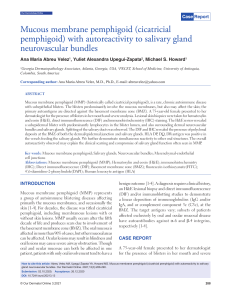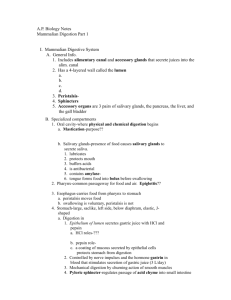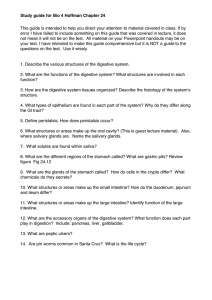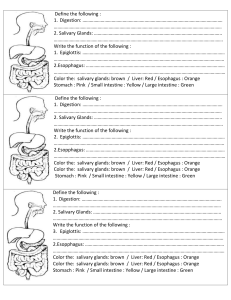Mucous membrane pemphigoid with reactivity to salivary glands
advertisement
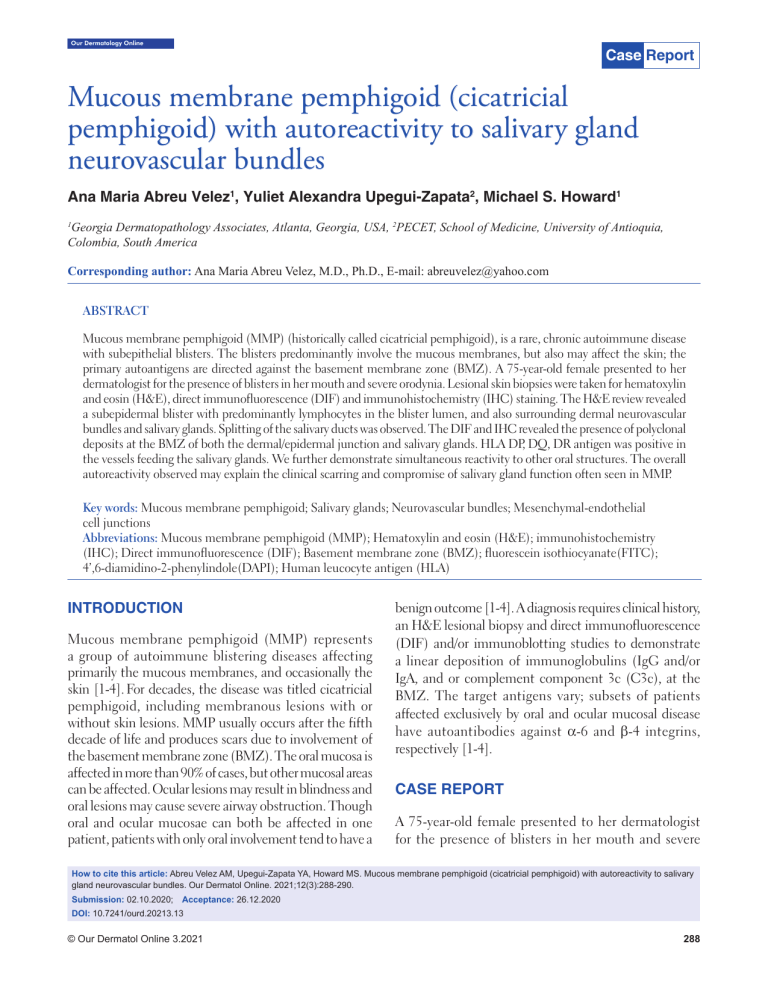
Our Dermatology Online Case Report Mucous membrane pemphigoid (cicatricial pemphigoid) with autoreactivity to salivary gland neurovascular bundles Ana Maria Abreu Velez1, Yuliet Alexandra Upegui-Zapata2, Michael S. Howard1 Georgia Dermatopathology Associates, Atlanta, Georgia, USA, 2PECET, School of Medicine, University of Antioquia, Colombia, South America 1 Corresponding author: Ana Maria Abreu Velez, M.D., Ph.D., E-mail: abreuvelez@yahoo.com ABSTRACT Mucous membrane pemphigoid (MMP) (historically called cicatricial pemphigoid), is a rare, chronic autoimmune disease with subepithelial blisters. The blisters predominantly involve the mucous membranes, but also may affect the skin; the primary autoantigens are directed against the basement membrane zone (BMZ). A 75-year-old female presented to her dermatologist for the presence of blisters in her mouth and severe orodynia. Lesional skin biopsies were taken for hematoxylin and eosin (H&E), direct immunofluorescence (DIF) and immunohistochemistry (IHC) staining. The H&E review revealed a subepidermal blister with predominantly lymphocytes in the blister lumen, and also surrounding dermal neurovascular bundles and salivary glands. Splitting of the salivary ducts was observed. The DIF and IHC revealed the presence of polyclonal deposits at the BMZ of both the dermal/epidermal junction and salivary glands. HLA DP, DQ, DR antigen was positive in the vessels feeding the salivary glands. We further demonstrate simultaneous reactivity to other oral structures. The overall autoreactivity observed may explain the clinical scarring and compromise of salivary gland function often seen in MMP. Key words: Mucous membrane pemphigoid; Salivary glands; Neurovascular bundles; Mesenchymal-endothelial cell junctions Abbreviations: Mucous membrane pemphigoid (MMP); Hematoxylin and eosin (H&E); immunohistochemistry (IHC); Direct immunofluorescence (DIF); Basement membrane zone (BMZ); fluorescein isothiocyanate(FITC); 4’,6-diamidino-2-phenylindole(DAPI); Human leucocyte antigen (HLA) INTRODUCTION Mucous membrane pemphigoid (MMP) represents a group of autoimmune blistering diseases affecting primarily the mucous membranes, and occasionally the skin [1-4]. For decades, the disease was titled cicatricial pemphigoid, including membranous lesions with or without skin lesions. MMP usually occurs after the fifth decade of life and produces scars due to involvement of the basement membrane zone (BMZ). The oral mucosa is affected in more than 90% of cases, but other mucosal areas can be affected. Ocular lesions may result in blindness and oral lesions may cause severe airway obstruction. Though oral and ocular mucosae can both be affected in one patient, patients with only oral involvement tend to have a benign outcome [1-4]. A diagnosis requires clinical history, an H&E lesional biopsy and direct immunofluorescence (DIF) and/or immunoblotting studies to demonstrate a linear deposition of immunoglobulins (IgG and/or IgA, and or complement component 3c (C3c), at the BMZ. The target antigens vary; subsets of patients affected exclusively by oral and ocular mucosal disease have autoantibodies against α-6 and β-4 integrins, respectively [1-4]. CASE REPORT A 75-year-old female presented to her dermatologist for the presence of blisters in her mouth and severe How to cite this article: Abreu Velez AM, Upegui-Zapata YA, Howard MS. Mucous membrane pemphigoid (cicatricial pemphigoid) with autoreactivity to salivary gland neurovascular bundles. Our Dermatol Online. 2021;12(3):288-290. Submission: 02.10.2020; Acceptance: 26.12.2020 DOI: 10.7241/ourd.20213.13 © Our Dermatol Online 3.2021 288 www.odermatol.com orodynia. The physical exam revealed eroded blisters in the mouth with erythema and edema (Fig. 1a). Skin biopsies for hematoxylin and eosin (H&E) staining, for IHC and DIF were obtained. Our IHC and DIF processing were performed as previously described [5]. A diagnosis of MMP was reached, and the patient received systemic treatment with corticosteroids and mycophenolate, resulting in lesional improvement. The patient was later sent for a multidisciplinary consultation with a dentist, ophthalmologist, otolaryngologist, gynecologist, and gastroenterologist. For our DIF, we classified the findings as negative (-), weakly positive (+), positive (+++) and strongly positive (++++). IHC double staining was performed using a Leica Bond Max platform autostainer. Specifically, for red staining we utilized a bond polymer refined red detection DS9390, an alkaline phosphatase linker polymer and fast red chromogen. For brown staining, we utilized bond polymer refined detection DS9800, a horseradish peroxidase linker polymer and DAB chromogen, all from Leica (Buffalo Grove, Illinois, USA). Positive and negative controls were consistently run. We utilized antibodies against HLA-DP, DQ, DR antigen, clone CR3/43, and CD45 clones 2B11 + PD7/26, both from Dako-Agilent(Carpinteria, California, USA). The H&E tissue sections revealed a subepithelial blister (Fig. 1b). Within the blister lumen predominantly lymphocytes were present, with occasional neutrophils and eosinophils. Within the dermis, a mild, superficial, perivascular infiltrate of lymphocytes, plasmacytoid cells, histiocytes, and a few eosinophils and neutrophils were identified near neurovascular bundles (Fig. 1b). Of interest, salivary duct lumina were filled with lymphocytes and some histiocytes. When cutting the biopsies with the microtome, the tissue easily separated at salivary gland lumina. Dermal scarring was not appreciated. The DIF showed separation of the salivary ducts, creating a cavity. We noted IgG, IgM, IgD, antihuman fibrinogen, anti-human albumin, anti-kappa, and anti-lambda all positive (++++) with a linear distribution at the basement membrane zone (BMZ) of the dermal-epidermal junction, and also at the salivary gland BMZs (Figs. 1c and d). Deposits were also noted around upper dermal neurovascular bundles, and in mesenchymal/endothelial cell junctions throughout the dermis. Interestingly, multiple dendritic-like cells in the dermis were positive with C1q (++++). The neurovascular bundles in the dermis were also positive for FITC conjugated IgA (+++), and Complement/ © Our Dermatol Online 3.2021 C3 was noted in a linear distribution at the BMZ (+++). HLA-DP, DQ, DR antigen was positive via IHC in the salivary gland ducts and neurovascular bundles (Fig. 1e). IHC also demonstrated CD45 positive clusters as part of the inflammatory infiltrate under the blister, and around the salivary glands and neurovascular bundles (Fig. 1f). DISCUSSION MMP is a chronic autoimmune disease of unknown etiology, frequently involving the oral cavity and a b c d e f Figure 1: (a) Shows two superficial ulcers from sphacelated blisters on an erythematous oral mucosa. (b) H&E stain showing the subepidermal blister (black arrow) (400X). (c) DIF showing positive staining of a salivary gland duct in green using FITC conjugated fibrinogen (white arrows), as well as simultaneous staining at the BMZ (green staining; red arrow) (400X) (d) DIF showing positive staining of a split salivary duct with anti-human FITC conjugated antibody (green staining) (white arrows), and also shows a positive stain at the BMZ of the dermalepidermal junction (green staining, black arrow) (400X). The nuclei of the cells were counterstained with DAPI (blue). (e) IHC using HLA DP, DQ, DR antigen shows positive staining in the vessels (fuchsia staining, black arrow) and the salivary glands (red arrow) (400X). (f) IHC using CD45 showing positive staining in the salivary glands (red staining, black arrow) (1000X). 289 www.odermatol.com sometimes the pharynx, larynx, esophagus, glottis, eyes (causing symblepharon) and genital mucosa [1-4]. Women are often more affected than men (ratio 2:1). The most common autoantigens described for MMP are bullous pemphigoid antigen 2 (BPAG2; BP180), bullous pemphigoid antigen 1 (BPAG1; BP230), integrins α6 and β4, laminin 5(laminin 332/epiligrin, α3β3, δ2 chain laminin), laminin 6 and type VII collagen [1-4]. It is characterized histologically by subepithelial blistering and by DIF featuring linear binding of IgG, IgA and C3 to the BMZ [1-4]. The predominance of mucosal involvement clinically distinguishes MMP from bullous pemphigoid. Consistent with our findings, other authors described three patients with cicatricial pemphigoid and positive immunofluorescence findings in the basement membrane zones of mucous glands in the pharynx, mouth, and nose [6,7]. The authors suggested that their findings were unique to cicatricial pemphigoid. In our case, the autoantibodies were present along the BMZ of the mucosal junctional zone, and the BMZs of the salivary glands and their ducts [6,7]. Here, we clearly demonstrate MMP autoantibodies to the basement membranes of salivary glands and their ducts, as well as to dermal neurovascular structures and the mesenchymal/endothelial cell junctions. These autoantibodies are present to multiple antibodies, complement, albumin and fibrinogen. Given our salivary gland findings, we suggest that their involvement could contribute to the scarring process. Like ocular tears, saliva has a complex composition including electrolytes, immunoglobulins, proteins, enzymes, and mucins. Enzymes from the salivary glands begin to digest carbohydrates, enzymes from the stomach digest proteins, and enzymes from the exocrine glands of the pancreas digest carbohydrates, proteins, lipids, RNA, and DNA. Muscarinic acetylcholine receptors (mAChRs), including M1-M5 subtypes, are classic receptors in regulating water, ion, and solute transport in salivary glands [8]. MMP autoantibodies including IgG (97%), C3 (78%) IgA (27%), and IgM (12%) are directed against multiple antigens including bullous antigens 1 and 2, laminins 332 and 311, type VII collagen, α6 β4-integrin, and unidentified basal membrane zone antigens, highlighting a diverse molecular etiology including part of the cell junctions [9]. Elderly females are commonly affected, with a mean onset age of 50–80 years. The predominant mucosal sites involved are the oral mucosa, ocular mucosa, oropharynx, larynx, and genital region. Skin involvement © Our Dermatol Online 3.2021 is usually restricted to the regions of head, neck, and upper torso. A distinguishing feature of MMP is the scarring of the mucosa after the erosions and blisters heal. CONCLUSION Integrins are present in the salivary glands, particularly subunits beta 1, beta 3 and beta 4; this feature may explain our observed reactivity to the salivary glands [10]. The observed reactivity to the salivary glands may account for the frequent clinical scarring in MMP. Regarding the observed reactivity of the dermal neurovascular bundles, our experience when investigating multiple autoimmune skin diseases is that neurovascular bundles often demonstrate autoimmunity. In the current case we do not know the molecular etiology of this finding, warranting further studies. REFERENCES 1. Carey B, Setterfield J. Mucous membrane pemphigoid and oral blistering diseases. Clin Exp Dermatol. 2019;44:732-9. 2. Buonavoglia A, Leone P, Dammacco R, Di Lernia G, Petruzzi M, Bonamonte D, et al. Pemphigus and mucous membrane pemphigoid: An update from diagnosis to therapy. Autoimmun Rev. 2019;18:349-58. 3. Wozniak K, Jakubowska B, Kalinska-Bienias A, Hashimoto T, Ishii N, Kowalewski C. Diagnosis of autoimmune subepidermal bullous diseases with mucous membrane involvement based on laser-scanning confocal microscopy. Eur J Dermatol. 2020 Sep 24. doi: 10.1684/ejd.2020.3765. 4. Branisteanu DC, Stoleriu G, Branisteanu DE, Boda D, Branisteanu CI, Maranduca MA, et al. Ocular cicatricial pemphigoid (Review). Exp Ther Med. 2020;20:3379-82. 5. Abreu-Velez AM, Upegui-Zapata YA, Valencia-Yepes CA, UpeguiQuiceno E, Mesa-Herrera NR, Jiménez-Echavarria AM, et al. Membrane attack complex (C5b-9 complex or Mac), is strongly present in lesional skin from patients with endemic pemphigus foliaceus in El Bagre, Colombia. J Cutan Pathol. 2019;46:9259. 6. Schmidt E. Increasing the diagnostic sensitivity for mucous membrane pemphigoid by detection of salivary autoantibodies. Br J Dermatol. 2016;174:956-7. 7. Ali S, Kelly C, Challacombe SJ, Donaldson ANA, Dart JKG, Gleeson M. et al. Salivary IgA and IgG antibodies to bullous pemphigoid 180 noncollagenous domain 16a as diagnostic biomarkers in mucous membrane pemphigoid. Br J Dermatol. 2016;174:1022-9. 8. Cong X, Min SN, Wu LL, Cai ZG, Yu GY. [Role and mechanism of muscarinic acetylcholine receptor in the regulation of submandibular gland secretion]. Beijing Da Xue Xue Bao Yi Xue Ban. 2019;51:390-3. 9. Samiei M, Ahmadian E, Eftekhari A, Eghbal MA, Rezaie F, Vinken M. Cell junctions and oral health. EXCLI J. 2019;18:317-30. 10. Loducca SV, Mantesso A, Kapas S, Williams DM, Araújo NS, Araújo VC. Salivary gland tumours: immunoexpression of integrins beta 1, beta 3 and beta 4. J Oral Pathol Med. 2003;32:305-9. Copyright by Ana Maria Abreu Velez, et al. This is an open-access article distributed under the terms of the Creative Commons Attribution License, which permits unrestricted use, distribution, and reproduction in any medium, provided the original author and source are credited. Source of Support: Nil, Conflict of Interest: Our work was supported by Georgia Dermatopathology Associates, Atlanta, Georgia, USA. 290
